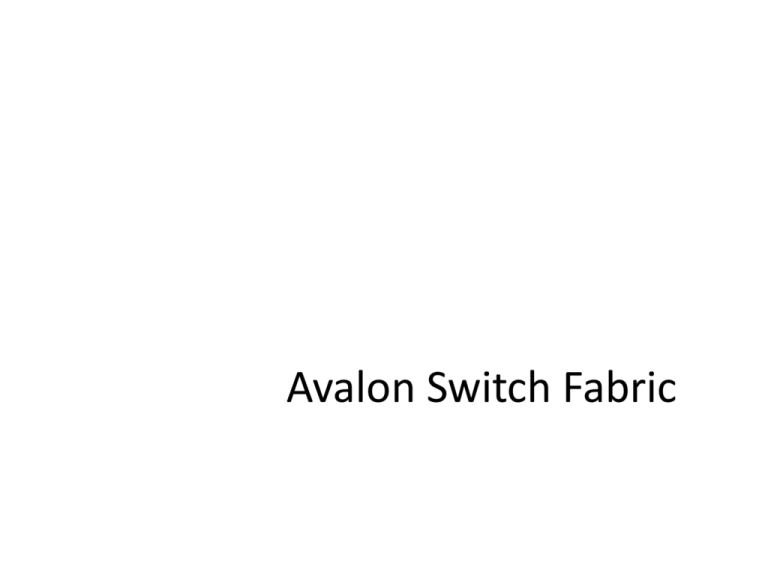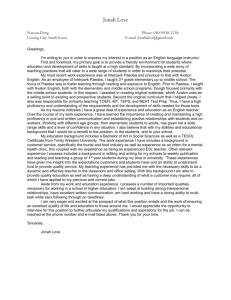Avalon Switch Fabric
advertisement

Avalon Switch Fabric Avalon Switch Fabric • Proprietary interconnect specification used with Nios II • Principal design goals • Transfer Types – – – – – 2 Slave Transfers Master Transfers Streaming Transfers Latency-Aware Transfers Burst Transfers Nios II Processor Switch PIO Address (32) Read 32-Bit Nios II Processor Write Data In (32) Data Out (32) IRQ IRQ #(6) ROM (with Monitor) UART Avalon Switch Fabric – Low resource utilization for bus logic – Simplicity – Synchronous operation LED PIO 7-Segment LED PIO PIO-32 Timer UserDefined Interface Avalon Switch Fabric • Custom-Generated for Peripherals – Contingencies are on a Per-Peripheral Basis – System is Not Burdened by Bus Complexity • SOPC Builder Automatically Generates – – – – – – 3 Arbitration Address Decoding Data Path Multiplexing Bus Sizing Wait-State Generation Interrupts Avalon Master Ports • Initiate Transfers with Avalon Switch Fabric • Transfer Types – Fundamental Read – Fundamental Write • All Avalon Masters Must Honor a waitrequest signal • Transfer Properties – Latency – Streaming – Burst 4 Avalon Slave Ports • Respond to Transfer Requests from Avalon Switch Fabric • Transfer Types – Fundamental Read – Fundamental Write • Transfer Properties – – – – 5 Wait States Latency Streaming Burst Slave Read Transfer 0 Setup Cycles 0 Wait Cycles A B C D E clk address,be_n address, be_n readn chipselect readdata 6 readdata Slave Read Transfer with Wait States 1 Setup Cycle 1 Wait Cycle A B C D E F H G clk address,be_n address, be_n chipselect Tsu readn readdata 7 readdata Slave Write Transfer 0 Setup Cycles 0 Wait Cycles 0 Hold Cycles A B C D clk address,be_n writedata writen chipselect 8 address, be_n writedata Slave Write Transfer with Wait States 1 Setup Cycle 0 Wait Cycles 1 Hold Cycle A B C D F E clk address,be_n writedata writen chipselect 9 address, be_n writedata G Multiple Clock Domains Supported Master Clock Domain 1 Master Clock Domain 2 Master Clock Domain 1 Avalon Switch Fabric CDX CDX Arbiter Avalon Switch Fabric Slave Clock Domain 2 Slave Clock Domain 2 Slave Clock Domain 2 Slave Clock Domain 2 CDX = Clock Domain Crossing Logic (inserted automatically by SOPC Builder) 10 Multi-Clock Domain Support Master Clock Domain 2 Master Clock Domain 1 CDX CDX Master Clock Domain 1 Arbiter CDX Arbiter Avalon Switch Fabric Avalon Switch Fabric Slave Clock Domain 3 CDX = Clock Domain Crossing Logic 11 Master Clock Domain 1 Slave Clock Domain 2 User-Defined Custom Peripherals • What if I need to add a peripheral not included with the Nios II system? – user wants to add own peripheral to perform some kind of proprietary function or perhaps a standard function that is not yet included as part of the Nios kit – Expand or accelerate system capabilities • We are now going learn how to connect our own design directly to the Nios II system via Avalon – As many peripherals contain registers we could also have chosen to connect to a PIO rather than directly to the bus 12 Creating Avalon Slave • No Need to Worry about Bus Interface • Implement Only Signals Needed Avalon Switch Fabric • Peripherals Adapted to by Avalon Switch Fabric Register File • Timing Handled Automatically User • Fabric Created for You Logic • Arbiters Generated for You Concentrate Effort on Peripheral Functionality! 13 New Component Editor 14 Creates Interface • Connect to Existing HDL or board component • Map into Nios II Memory Space • Can be “Inside” or “Outside” Nios II System I/O I/O Nios II CPU 15 I/O I/O Interface to User Logic I/O Avalon Avalon Nios II System Module Nios II CPU I/O External User Peripheral Nios II System Module I/O I/O Internal User Peripheral Create External Component Interface • To communicate with off-chip peripherals • Base interface type on data sheet 16 AMD29LV065AD CFI Flash Chip Or Add HDL Files 17 For peripheral that has been encoded for FPGA Tri-State Peripherals • Require Tri-State Bridge Interface to User Logic Tri-State Bridge Nios II Processor Avalon – Available as an SOPC Builder component Off Chip Peripheral FPGA • Tri-State peripheral is defined by the presence of a bi-direction data port • Off-chip peripherals do not have to be tri-state 18 Define Component Signals Automatically populates port table from design files Enter port type here Can also define ports manually 19 Define Interface for Each Signal Type Choose interface type Register Slave uses native alignment, Memory Slave uses dynamic alignment Control Read and Write Timing Add wait and hold states View waveforms 20 Address Alignment – Narrow Slave 32 Avalon 32-Bit Nios II Processor Peripheral Registers 8 8 Bit Peripheral Base aa Base + 0x1 bb Base + 0x2 cc Base + 0x3 dd Base + 0x4 ee • Dynamic Address Alignment (set as Memory Slave) – LD from Base + 0x0: dd cc bb aa – LD from Base + 0x4: uu uu uu ee • Native Address Alignment (set as Avalon Register Slave) – LD from Base + 0x0: uu uu uu aa – LD from Base + 0x4: uu uu uu bb – LD from Base + 0x8: uu uu uu cc 21 Address Alignment – Narrow Master 32 Avalon 32-Bit Nios II Processor Memory Contents 64 64 Bit Memory • Dynamic Address Alignment – LD from Base + 0x0: – LD from Base + 0x4: – LD from Base + 0x8: Base 77 66 55 44 33 22 11 00 Base + 0x8 ff ee dd cc bb aa 99 88 Base + 0x16 ?? ?? ?? ?? ?? ?? ?? ?? 33 22 11 00 77 66 55 44 bb aa 99 88 • Native Address Alignment – LD from Base + 0x0: 33 22 11 00 – LD from Base + 0x4: bb aa 99 88 – LD from Base + 0x8: ?? ?? ?? ?? – High bytes are unobtainable – warning issued 22 Add Software Files 23 ie. Header files and drivers Add Software Files 24 Header file and drivers can also be added directly to Application Project Create Component Wizard Publish and create a wizard for your component Fill in fields Add component to SOPC Builder portfolio Can add parameterizing capability to component 25 Add Component to SOPC System • Default location is the User Logic folder 26 Intel PXA255 Example 27 VLIO as an Avalon Master Port VLIO • Intel PXA255 Variable Latency I/O (VLIO) Uses a Bi-Directional Data Path, RDY Signal to Add Wait States Interface Separates DATA into Read Data & Write Data Paths • 28 Relevant Verilog Code to Relevant Verilog Code to Implement 29








